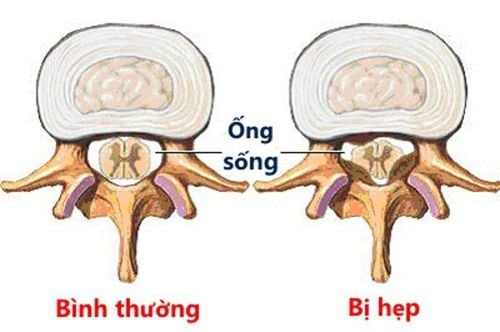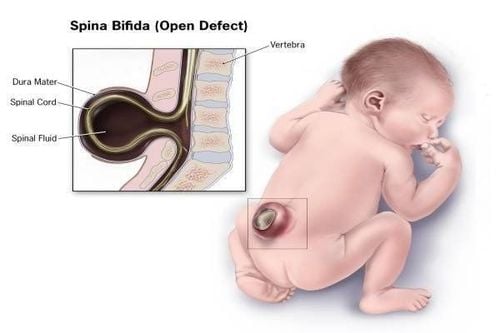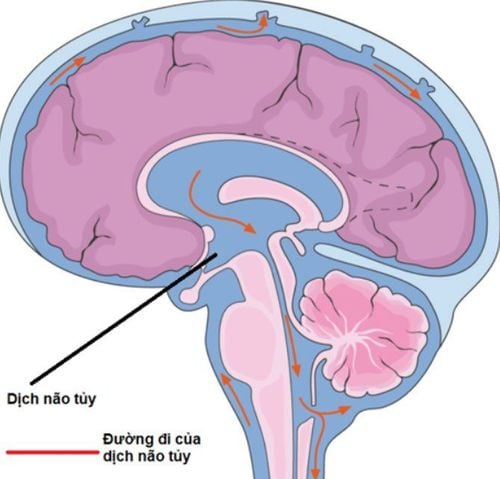This is an automatically translated article.
The article is expertly consulted by MSc.BS Bui Ngoc Phuong Hoa - Department of Medical Examination & Internal Medicine - Vinmec Danang International General Hospital.
Cerebrospinal fluid is a clear, colorless liquid that surrounds the brain and spinal cord. When your doctor thinks you have a disease that affects your nervous system (especially the central nervous system), you may be ordered to have your cerebrospinal fluid tested.
1. What is cerebrospinal fluid?
Cerebrospinal fluid is made by a group of cells, called the choroid plexus, located deep in the ventricles; On average, each adult has about 150 ml of cerebrospinal fluid. As this colorless fluid flows around the brain and spinal cord, it cushions these organs, supplies the brain with essential substances from the blood, and removes waste products from brain cells. Sometimes the cerebrospinal fluid can have things it shouldn't, like bacteria or viruses that can attack the brain and cause serious illness.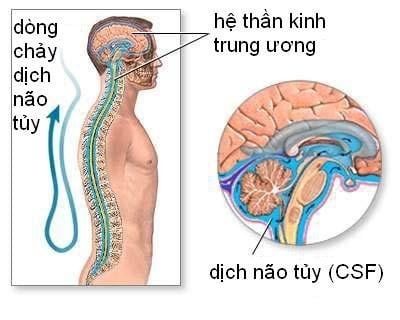
2. Origin of cerebrospinal fluid
Cerebrospinal fluid is produced by the choroid plexus (basal in the lateral ventricles), filled in the lateral ventricles, through the foramen of Monro into the third ventricle, through the foramen of Luschka into the subarachnoid space of the brain, and through the foramen of Magendie with the subarachnoid space of the spinal cord; Cerebrospinal fluid is reabsorbed intravenously by Pacchioni granules. Normally, about 20ml of CSF is produced every hour and at the same time the same amount of CSF is absorbed; On average, within 24 hours, the cerebrospinal fluid of a person is changed 3 times. The biological composition of the cerebrospinal fluid is frequently regulated by interfacial regions. It is the system of blood-brain barriers, blood-cerebrospinal fluid (choroidal plexus) and cerebrospinal fluid-blood (Pacchioni granules of the meninges).3. Composition of cerebrospinal fluid
3.1. Cell composition In the cerebrospinal fluid of normal adults, each microlite has 0 to 5 lymphocytes or mononuclear cells, no polymorphonuclear cells and red blood cells.3.2. Other components Protein = 38.2 mg/dL and IgG 9.9 Glucose = 61 mg/dL (65% of plasma value). Chloride = 124 mEq/L (120% of the plasma value). Lipid = 1.25 mg/dL, including phospholipids, nonphosphorus sphingolipids, cholesterol, cholesterol esters and triglycerides Other components are in very small quantities. A large number of substances present in the cerebrospinal fluid are also found in the blood, but not all substances present in the blood are found in the cerebrospinal fluid. Example: Beta-Lipoprotein and Fibrinogen are not found in CSF. Therefore, it is always necessary to measure substances in the blood at the same time to compare them with the amount of that substance in the cerebrospinal fluid, especially glucose and chloride ions. Protein: Cerebrospinal fluid in the ventricles contains 10 mg, in the large tank 20 mg, in the lumbar spine subarachnoid space is 40 mg/dL. Glucose: 60 mg/dL in the ventricles, 50 mg/dL in the large tank, 40 mg/dL in the lumbar spinal subarachnoid space.
4. Function of cerebrospinal fluid
In the early fetal stage: cerebrospinal fluid is responsible for nourishing, that function gradually disappears as the fetus grows. Cerebrospinal fluid lubricates and cushions the brain and spinal cord with the dura mater and the outer hard bones (cranium, spine). Protects the brain and spinal cord against mechanical trauma, and participates in the nutritional and metabolic tasks of the central nervous system;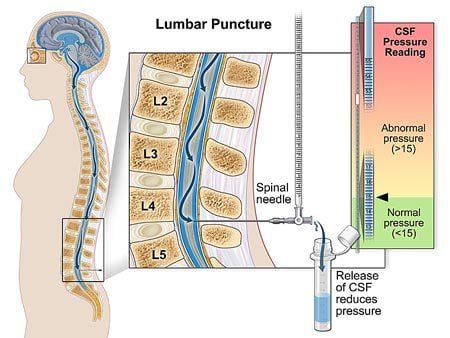
5. Cerebrospinal fluid test to identify the disease
Elevated levels of immunoglobulins in the cerebrospinal fluid may be a sign of multiple sclerosis. If a person has Alzheimer's disease or another type of dementia, certain proteins associated with the disease may be present in the cerebrospinal fluid. Cerebrospinal fluid is discolored: red can cause bleeding in the brain (bleeding in the brain), yellow (tuberculous meningitis),... Signs of a bacterial or viral infection can tell the doctor that the patient is sick such as meningitis or encephalitis.6. Methods of obtaining cerebrospinal fluid
6.1. To obtain cerebrospinal fluid, three routes can be obtained. Ventricular extraction (usually done in combination during surgery); Taken from a large tank (selective method of large tank or suboccipital puncture), indicated in special cases; Obtained from the lumbar spinal subarachnoid space (lumbar puncture), which is the route commonly indicated in clinical practice;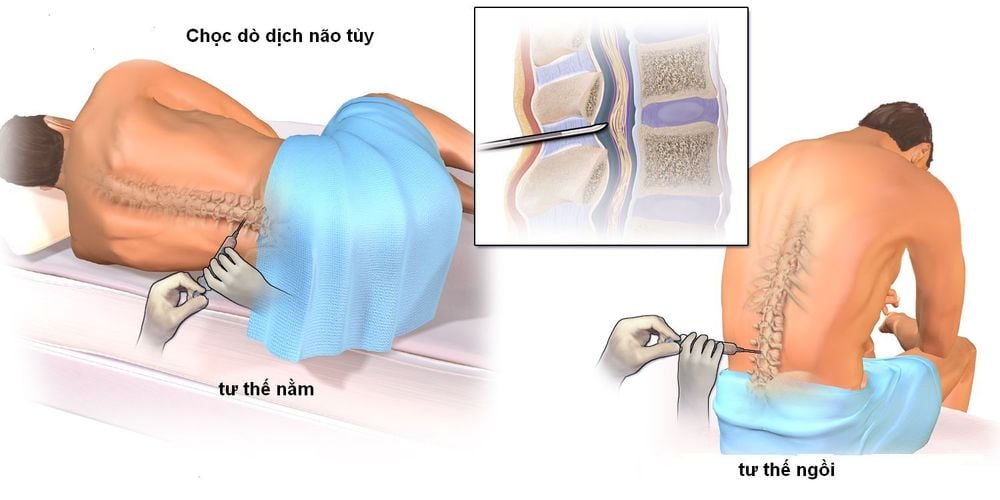
6.2. Indications: Cerebrospinal fluid test plays a very important role in the detection, diagnosis and treatment of diseases.
Research on cerebrospinal fluid pressure, cerebrospinal fluid circulation: increased rate in case of increased intracranial pressure (with intracranial shock), decreased rate in spinal cord compression (spinal tumour), .. Test of cerebrospinal fluid (biochemical changes, cells, microorganisms, pH, quantification of enzymes, neurotransmitters....); Myelogram, root capsule with contrast injection... (currently rarely used because of the support of MRI) For treatment: Give specific drugs into the subarachnoid space of the spinal cord. Giving local anesthetics for surgical purposes. Give antibiotics, anti-cancer drugs, corticosteroids... to treat diseases of the central nervous system or nerve root diseases. To monitor treatment results 6.3. Contraindications Increased intracranial pressure Brain tumor Severe brain edema Neck spinal cord injury Infection in the lumbar skin (needle puncture area) Coagulation disorders (hemophilia, thrombocytopenia, patients on antiretroviral therapy) blood clotting). 6.4. Possible complications and complications: Brain herniation Infection (abscess at puncture site, purulent meningitis...) Headache after lumbar puncture Bleeding (causing epidural hematoma or bleeding) subarachnoid blood...) Master. Doctor Bui Ngoc Phuong Hoa has more than 24 years of experience in the field of neuropsychology. Doctor Hoa was formerly the Deputy Head of the Department of Neurology - Quang Ngai Provincial General Hospital and participated in many continuous training courses on Epilepsy, Cerebrovascular Accident, Alzheimer's, Movement Disorders, Geriatrics. Endocrine Pathology.
Please dial HOTLINE for more information or register for an appointment HERE. Download MyVinmec app to make appointments faster and to manage your bookings easily.
Article reference source: Webmd.com






